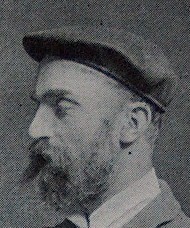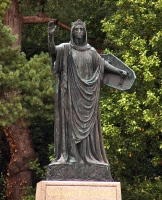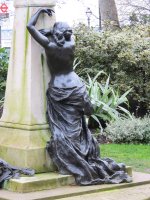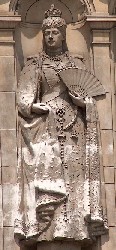William Goscombe John (1860-1952)
A visit to Cardiff suggests William Goscombe John was not just the leading Welsh sculptor, but the predominating one. Not only does the National Museum of Wales contain a room devoted to his works, but half the public monuments in the area seem to be by him, and a walk out to Llandaff Cathedral finds a war memorial and two effigies of churchmen by this most prolific sculptor.
Goscombe John was from a family of craftsman, his father being a woodcarver, and he started work assisting his father on the restoration of Cardiff Castle under William Burges. Then, in London, he worked for Farmer and Brindley, taking evening classes in sculpture under W. S. Frith and Dalou, at the Lambeth School of Art, where his fellow-pupils included some of the most important New Sculptors Harry Bates, George Frampton, and F. W. Pomeroy. He then attended the Royal Academy Schools, worked as assistant to C. B. Birch for a period, visited Greece, Egypt and Italy on the advice of Lord Leighton in 1889, and on winning a travelling award from the Academy, on Burne-Jones advice went to the Mediterranean. A year in Paris followed, and in that year, 1891, he sent his first large statue, entitled Morpheus, to be exhibited at the RA. His Boy at Play was bought under the terms of the Chantrey Bequest in 1896. He was elected Royal Academician in 1909, and knighted in 1911. In 1912 he helped found the National Museum of Wales.
War Memorial, Llandaff, central figure, by Goscombe John.
As a New Sculptor, Goscombe John produced in his early years a variety of naturalistic figures (nude girls, young boys, a few mythological figures including a Merlin and Arthur, and religious ones such as St John the Baptist). However, he is best known as a portrait sculptor, producing many busts and full statues of eminent men, and memorial work for churches, cathedrals and war memorials. At his best, his portraits give the impression of strength of character, wit and individuality. His naturalistic work, to my mind, is rather cooler and less intense than that of some of his contemporaries, and he did not aim for ideal beauty in his mythological subjects.
A representative selection of his work may be seen in the National Museum of Wales (including St John the Baptist and the Drummer Boy, a version of which was used in St John's Gardens, Liverpool), and elsewhere in Cardiff. Among his portrait statues we should mention Dean Vaughan and Bishop Lewis in Llandaff Cathedral, Judge Gwilym Williams, Viscount Tredegar and Lord Ninian Crichton-Stewart in Cathays Park, and St David is in Cardiff City Hall. In England he was the Duke of Devonshire for Eastbourne (which won a gold medal at the Paris Salon) - see this page for picture, the Marquess of Salisbury for Westminster Abbey, Edward VII for Liverpool, Prince Christian Victor for Windsor, and Edward VII and Princess Alexandra for the front of the Victoria and Albert Museum. A particularly excellent thing in London is his monument to Arthur Sullivan (picture above, click to enlarge) on the Victoria Embankment. We should also mention his equestrian portrait of Viscount Wolseley in Horseguards Parade, pictured in full on this page.
Queen Alexandra, V&A, by Goscombe John.



